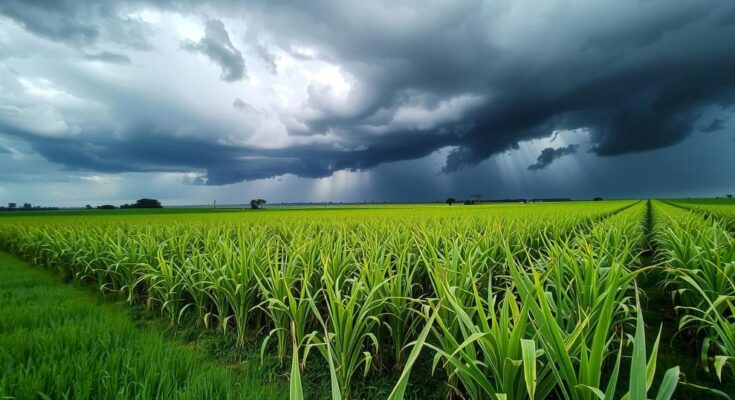Sugar prices have dipped due to forecasts of rain in Brazil improving sugarcane yields. Recent reports indicate lower global sugar production, particularly affecting Brazil and India. The International Sugar Organization has raised deficit forecasts, while projections for increased production in Thailand exert additional bearish pressure on sugar prices. Overall, the evolving situation requires careful observation by market stakeholders.
Sugar prices have experienced a decline due to anticipated rain in Brazil, which is expected to alleviate dryness and potentially enhance sugarcane yields. As of today, May New York world sugar 11 is down by 0.18 points (0.94%) while May London ICE white sugar 5 fell by 1.40 points (0.26%). These changes mark a retreat from their recent two-week highs driven by signs indicating lower global sugar production.
Earlier in the week, sugar prices rallied to a two-week peak amid reports of reduced output globally. The Brazilian sugar production report from Unica indicated a drop of 5.6% year-on-year for the cumulative output through February, diminishing expectations of supply. Similarly, the Indian Sugar and Bio-energy Manufacturers Association adjusted their forecast for India’s sugar production, lowering it to 26.4 MMT from an earlier 27.27 MMT, attributing this change to diminished cane yields.
The International Sugar Organization (ISO) revised its prediction for the global sugar deficit in 2024/25, increasing it to 4.88 MMT from 2.51 MMT previously. Additionally, the ISO cut its forecast for global sugar production to 175.5 MMT, indicating a tightening supply chain from the surplus of 1.31 MMT in 2023/24. Green Pool Commodity Specialists also projected a shift to surplus in 2025/26, estimating a surplus of 2.7 MMT after a deficit in 2024/25.
Market sentiment turned bearish following a significant delivery of 1.7 MMT of raw sugar recorded by sugar traders Wilmar International Ltd and Sucres et Denrees SA. This delivery against the March New York futures contract, which recently expired, reflects weak demand for sugar, typically suggesting fewer market opportunities for sellers. Additionally, projections for Brazilian sugar production are comparatively high due to the attraction of profits from sugar over ethanol, further contributing to pressures on prices.
India’s government recently eased restrictions on sugar exports, permitting a shipment of 1 MMT this season. The ISMA predicted India’s sugar production will decline to a five-year low, affecting supply dynamics. Meanwhile, Thailand’s anticipated increase of 18% in sugar production for 2024/25 adds further bearish sentiment to the market, as the country is one of the world’s leading sugar producers and exporters.
Persistent drought and excessive heat from last year have negatively impacted Brazil’s sugar crops, particularly in its largest sugar-producing state, Sao Paulo, where as much as 5 MMT of sugarcane may have been lost. Consequently, Brazil’s crop forecasting agency, Conab, revised its sugar production estimate downward.
The USDA has forecasted a 1.5% rise in global sugar production in 2024/25, combined with a projection of 1.2% growth in human sugar consumption. However, it also predicts a decline in global sugar ending stocks, contributing to the ongoing complexities of sugar market operations.
This market analysis highlights the dynamic nature of sugar pricing affected by weather forecasts, production adjustments, and trade policies, underscoring the importance of close monitoring for stakeholders.
In conclusion, sugar prices have declined due to favorable rain forecasts in Brazil, potentially leading to higher sugarcane yields. The market is further influenced by reduced global sugar production reports and an increase in anticipated production from other countries such as Thailand. Additionally, the recent easing of export restrictions by India may contribute to changing dynamics. Stakeholders must continue to monitor these developments carefully as they affect price trends.
Original Source: www.tradingview.com




